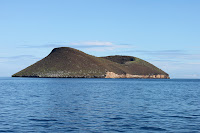 |
| Daphne Major at Sunset |
Visitors will not be scheduled for landings on Daphne Major or Daphne Minor, and your boat is likely to circumvent these islands during your cruise. Still, the scientific research that occurs on these two islands is important. Both also provide excellent underwater diving opportunities.
 |
| Daphne |
Daphne Major consists of a tuff cone (for an explanation of tuff cones, see
my earlier post on volcanoes) and a largely barren landscape. At its highest point the island is just 394 feet above sea level and it is 1.9 square miles in size.
 |
Medium Female Spot Ground Finch
by Kookr Creative Commons |
Though very near Baltra, and thus easy to get to, the Galapagos National Park Service restricts visits to Daphne Major, instead making it the situs of research into the important Darwin Finches. This intensive study has been recorded in the Pulitzer Prize winning book,
The Beak of the Finch. This book is described as “ground breaking” as it expounds on Darwin’s original findings that the Galapagos finches had adapted to their environment and his theory of natural selection. The book is summarized as follows: “on a desert island in the heart of the Galapagos archipelago, where Darwin received his first inklings of the theory of evolution, two scientists, Peter and Rosemary Grant, have spent twenty years proving that Darwin did not know the strength of his own theory. For among the finches of Daphne Major, natural selection is neither rare nor slow: it is taking place by the hour, and we can watch.”
 |
Medium Spot Ground Finch
by Stitwise Creative Commons |

| Juvenile Ground Finches | by John Jackson Northwestern University |
|
 |
| Photo by Nature and Wildlife |
Finches are not Daphne Major’s only inhabitants, however. Many other bird species are found there including Galapagos Martins, Blue Footed Boobies, Nazca Boobies, Short-Eared Owls, Red-Billed Tropic Birds and Magnificent Frigatebirds.

In particular, the majestic Red Billed Tropicbirds nest on Daphne Major’s cliffs. This bird has long white tail feathers and is distinguished by its radiant red bill.
Though there is very little vegetation at all on Daphne Major (take a look at the photo to see just how barren it is), Frigatebirds find a way to build their nests in the grasses on the slopes and near the crater’s rim. Blue Footed Boobies are always a favorite site. As you cruise by this island, you may, in fact, see thousands of birds congregating overhead.
 |
| Photograph Dragon Speed Flickr Creative Commons |
Daphne Minor is a small island, badly eroded, and has no human visitor sites, though it does get visited all the time by non-human species of birds.
I have seen both Daphne Major and Minor many times. They rise from the sea and evoke their volcanic beginnings as well as the inevitable erosion taking place throughout the Galapagos Islands. They provide awesome photo opportunities. Their bird life is prolific - the noise from these islands can be almost deafening. When you go to Baltra, be sure to take a look to the west.






 In particular, the majestic Red Billed Tropicbirds nest on Daphne Major’s cliffs. This bird has long white tail feathers and is distinguished by its radiant red bill.
In particular, the majestic Red Billed Tropicbirds nest on Daphne Major’s cliffs. This bird has long white tail feathers and is distinguished by its radiant red bill.

No comments:
Post a Comment